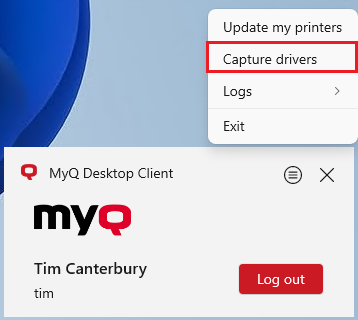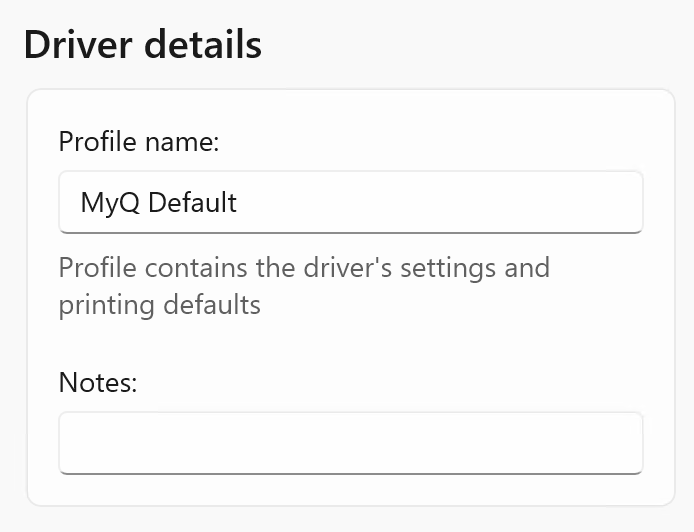Prepare and Capture Template Printers
As a first step, you will want to create your print driver configurations. After that, you will capture them, upload them to the MyQ X server, and finally test the setup.
Prepare template printers (install print drivers, create system printers and ports, and connect everything to have printers that are ready for print).
Capture template printers (select printers in the MyQ Desktop Client, upload them on the Print Server).
Prepare Template Printers
Install Print Drivers
The first step for this deployment is to collect the print drivers you will want to install and create printers as if you were doing it on a user’s machine. Source these drivers from the manufacturers' download pages.
Recommendations for print drivers:
Use official manufacturer’s drivers.
Preferably, use device-specific or universal drivers in a traditional mode configured on a physical device. Universal drivers in dynamic mode might display prompts to the user to search devices on the network. Also, some drivers, e.g. HP Universal Print Driver may not allow for print in color when not configured on a specific model.
In a mixed fleet environment, try selecting drivers published for your target devices to achieve the best compatibility. You might be able to print successfully to a device even through a driver of a different manufacturer thanks to MyQ’s cross-vendor printing support, but you will not get all the functionalities of the device.
Create Printers and Assign Print Drivers
Add your printers as normal:
Windows: Control Panel/Settings – Devices & Printers – Add manually.
macOS: System Settings, then click Printers & Scanners –
+option or via CUPS configuration.
Select the installed driver in the printer’s settings:
Windows: Control Panel/Settings – Devices & Printers – open a printer – Printer properties – Driver or in the Start menu – search and open “Print Management” – Print servers – Printers.
macOS: during the printer creation or, if the printer already exists, via CUPS configuration.
Assign a TCP/IP port to the printer:
Windows: Control Panel/Settings – Devices & Printers – open a printer – Printer properties – Port or in the Start – search and open “Print Management” – Print servers – Printers.
macOS: during the printer creation or, if the printer already exists, via CUPS configuration.
The queue name in the LPR port can be used to automatically attach the print driver configuration profile to a queue. If a queue with the same name already exists in MyQ, the profile is automatically assigned to it. This way you can instantly deploy or update the driver without further configuration.
Configure the desired driver’s capabilities and settings such as finishing options:
Windows: Printer Properties – General – Preferences or Printer Properties – Advanced – Printing Defaults.
macOS: during the printer creation or, if the printer already exists, via CUPS configuration.
Test your configuration.
Capture Driver and Settings
Run the MyQ Desktop Client on the template computer.
Sign in to the Desktop Client as a user with
AdministratororManage settingsrights.Right-click on the MyQ Desktop Client icon to open a context menu and select Capture print driver, a dialogue is opened with a list of printers.

Select printers that are using drivers you want to capture.

By clicking the printer once, you select it for capture and open the Driver details for this printer. By clicking it again, you deselect this printer. If you select another printer (and select it), clicking another printer once opens its details, click again to deselect it.
Specify the name of the print driver configuration profile; if it does not exist in MyQ already, a new profile with this driver will be created. If you specify an existing profile, the driver will be added to it. Read about the print driver configuration profiles below.
Once you select all required printers and specify the profiles they should be uploaded in, click Upload. Drivers will be compressed into ZIP files and uploaded to the MyQ Print Server.
About Print Driver Configuration Profiles
Configuration profiles for print drivers effectively bundle a collection of drivers that will be installed when queues are deployed. In a profile, you can have one instance of a print driver for every supported OS (Windows x64, Windows ARM, macOS).
When you assign a profile to a queue, MDC will install the driver it runs on automatically.
For this to work, it is necessary to capture a driver on various operating systems and upload all of them under one configuration profile name.
When capturing the driver in MDC, specify a profile name that already exists in MyQ.
If this profile already contains a driver for this OS, it is replaced by the new one.
If the profile does not contain a driver for this OS, this driver is added.

Example: Kyocera driver with stapling enabled for Windows 64bit and macOS
On Windows 64bit, the administrator installs a Kyocera driver, enables stapling in the driver’s printing defaults settings, and assigns this driver to the printer called “Kyocera Stapling Left”.
Using the Desktop Client, the driver is captured and uploaded to the MyQ driver store; a new configuration profile “Kyocera Stapling Left” is created.
Now, on macOS, the administrator also installs the preferred Kyocera driver, enables stapling in the driver’s settings, and during the driver capture, provides the same profile name to upload the driver under the same profile (“Kyocera Stapling Left”).
The administrator goes to the Print Drivers settings in MyQ, and in this print driver configuration profile selects the queue “Staple_Left” and sets the final name of the installed printer to ”Left Stapling” in MyQ.
Users running MDC on Windows and macOS with the right to print to queue “Staple_Left” will get the printer “Left Stapling” installed in the background; the correct driver for their platform will be used.
MyQ Driver Store
Once this setup is finished, confirm that the print drivers were successfully uploaded to the MyQ Print Server you see present in the driver store (Settings – Print Drivers).
Read more about Print Driver settings in Print Server 10.2 here.
